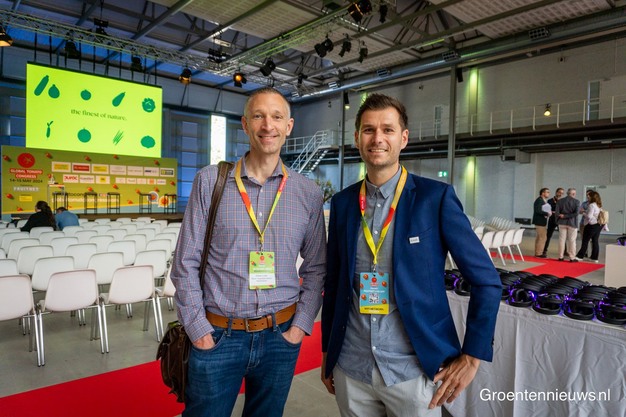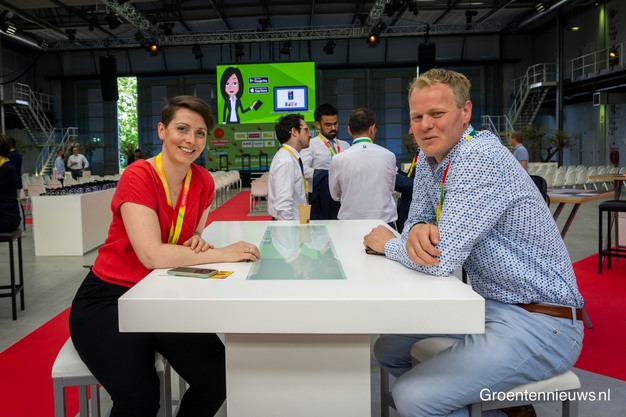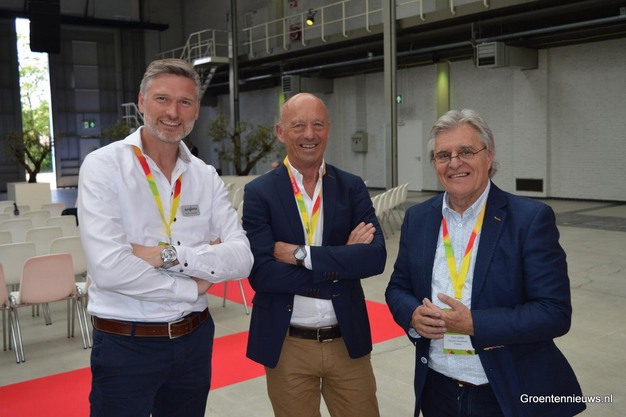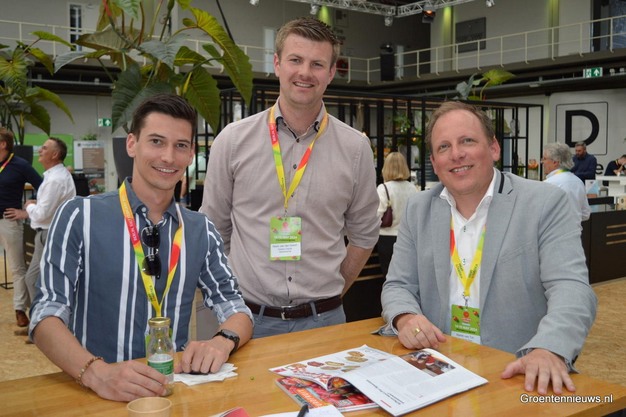Does taste matter? If you ask this question to a speaker at the Global Tomato Congress, the answer is quite predictable. The answer is 'yes,' often followed by something like 'ever since we started.'
However, in recent years, taste seemed to have taken a back seat, even at the annual event organized by Fruitnet, as much attention was focused on ToBRFV resistances. That is still the case, but the market is now ready to once again focus on taste and quality and to communicate about this for the significantly expanded list of resistant varieties.
Click here for the photo report
"Stop with promotions"
The event started on Tuesday, and continues today with several company visits in the Netherlands.
Yesterday, sponsors, speakers, and (international) visitors were gathered at the Fokker Terminal in The Hague, Netherlands. As is traditional, they were first given some statistics and figures to chew on by Rabobank researchers. Lambert van Horen showed that vegetables in general, and tomatoes in particular, have become more expensive, but consumers are still willing to pay the higher price for tomatoes.
A recurring theme is how the market can increase tomato consumption beyond lunch and dinner. Promotions and discounts at supermarkets are used for a general increase in sales. The bank researcher is not a fan of this. According to him, it only shifts consumers from one supermarket to another, costs the supply chain money, but does not increase overall sales.
Communication to the consumer
Several speakers revisited Lambert's statements throughout the day, especially when consumer research and sales data were thoroughly analyzed. Presentations from Azura, RedStar, BelOrta, and ICA addressed this topic. Arnaud Lefebvre and Zinaida Kapustina were the first to present such figures.
They see opportunities for renewed growth in the snack segment, and in France, room for a unique brand focused on 'feel-good snacking.' A challenge: the strict French packaging law that has banned plastic use since January 1st. Nevertheless, a transparent plant cellulose plastic packaging was created, allowing the tomatoes to be seen and communicated to the consumer.
 Ethan Luth and Steven Adriaense from Bayer De Ruiter.
Ethan Luth and Steven Adriaense from Bayer De Ruiter.
Communication about quality
But what do you communicate? At WUR, they see future possibilities to communicate data about quality once insights are available through image analysis and sensor use. Eva Ketel gave a presentation on this. Said Ouraich from Delassus acknowledged that extreme heat is especially challenging for the taste of tomatoes grown in Morocco. The major tomato company is more confident about maintaining a good shelf life.
Eva pointed out a good example of such communication from the Netherlands. Recently, spinach at Albert Heijn was labeled with information about hail damage. Martijn van Keulen from RedStar, like Glenn Sebregts from BelOrta, argued for thinking from the consumer and the supply chain's perspective. Consumer-centric marketing in jargon.

Lucie Cardon from Normec and Evert Keuken from Agri Information Partners.
Firmness
According to research Martijn presented, consumers, for example, want to know the best use for a tomato in a dish. Currently, 13% of consumers might be unsure after purchase. The risk is a disappointment after preparing a dish and then not buying again. The tomato specialist from De Lier is focused on ensuring that repeat purchase by emphasizing consistent taste.
Karin Gorree from Normec Foodcare presented figures on that consistency in taste. Weekly analyses of tomatoes on supermarket shelves show that over the past three winters, consumers noticed little of the challenges the tomato market faced. In other words, the effects of colder cultivation and resistant varieties were not really observed by consumers. However, lab researchers did find differences, with Karin emphasizing the importance of firmness in tomatoes.
 Ruud Kaagman and Rik Lootens (Syngenta) and Yvo Lens (Gautier Semences).
Ruud Kaagman and Rik Lootens (Syngenta) and Yvo Lens (Gautier Semences).
Speed with quality
Breeders from Hazera, BASF | Nunhems, Rijk Zwaan, and Norfolk Healthy Produce shared what they are working on. Michal Taraska and Robbert Biemans from Hazera drew a comparison between former top sprinter Dafne Schippers and the breeding process. In breeding, you also want speed, but quality, especially taste in tomato breeding, must not be forgotten.
Representing Norfolk, Nathan Pumplin pointed out that more consumers are willing to buy a genetically modified product than the market thinks, especially if it offers health benefits. Norfolk has launched a purple GMO tomato.
"New varieties simply better"
Geert Janssen from BASF | Nunhems and Paul Simmonds from Rijk Zwaan mainly discussed ToBRFV. With an increasingly complete virus map from EPPO (Geert dared to indicate a much wider spread of the virus than the official map shows, with only Australia being a large virus-free area), resistance is crucial. Even for countries or growers that are still virus-free, Paul noted. For example, Rijk Zwaan introduced a resistant variety in China to a grower without any virus presence, simply because the new resistant varieties are better, Paul emphasized.
 Max van den Hemel and Niels van der Geest from Delphy Digital and Martin van Tol from LetsGrow.com.
Max van den Hemel and Niels van der Geest from Delphy Digital and Martin van Tol from LetsGrow.com.
"Sustainability must not come at the expense of taste"
Towards the end of the long and increasingly warm day, technology was also addressed. At that moment, Margriet Looije from Looye Kwekers emphasized in a panel on sustainability the importance of having enough available techniques.
Timo Kleijwegt from Certhon introduced the harvest robot Artemy. Sam Gui discussed modern techniques in biological crop protection. Martin van Tol from LetsGrow.com, Cedric Canovas from Source.ag, Ronald Hoek from Blue Radix, and Niels van der Geest from Delphy Digital closed the day with presentations on the importance of good software, data, and how artificial intelligence can help.
According to Margriet Looije, more sustainable cultivation with the help of modern technology is important for growers' license to produce and not as a competitive advantage. Therefore, knowledge must be shared. The tomato company, which controls the entire chain from cultivation to sales, aims to be climate-neutral by 2040 and climate-positive by 2050.
The latest greenhouse Looye is currently building in Burgerveen is a step forward, saving thirty percent energy compared to a traditional greenhouse, Margriet shared. Anyone who thinks that sustainability comes at the expense of taste is mistaken, according to her. "Sustainability must not come at the expense of taste."
Click here for the photo report
For more information on the Global Tomato Conference:
https://www.fruitnet.com/tomatocongress
